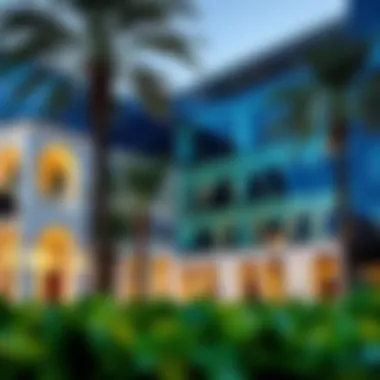Discover Local Gems: Your Guide to Attractions in Dubai


Intro
When you think of Dubai, the iconic skyline, grand shopping malls, and luxurious resorts likely come to mind. However, there's far more under the surface just waiting to be explored. From hidden gems to well-known hotspots, the local attractions can greatly enrich one’s experience, whether you are a resident or just passing through. Diving into nearby attractions not only broadens your understanding of the city but also deepens your emotional connection with it.
By exploring these local features, you come to discover the heart and soul of Dubai, which often lies in its vibrant markets, historical sites, and unique eateries. By tuning into the rhythm of the city, you’ll uncover experiences that tourists miss, giving you a more authentic taste of Dubai's culture.
As we meander through this guide, keep in mind that each section aims to illuminate a different facet of nearby attractions, coupled with practical tips and insights. Whether you’re seeking bustling outdoor markets or serene parks, the aim is to equip you with the knowledge to navigate efficiently through what Dubai has to offer.
Foreword to Nearby Attractions
Exploring nearby attractions is not just a matter of curiosity; it can drastically enhance one's experience in a new or familiar place. Whether you're a resident of a thriving city or a visitor on a fleeting trip, the opportunities for discovery are manifold. Knowing what’s just around the corner can transform an ordinary outing into a memorable adventure. This guide serves as a beacon for anyone looking to uncover the hidden gems and celebrated sites that a locale has to offer.
Defining Nearby Attractions
When discussing nearby attractions, it is essential to clarify what constitutes the term. Nearby attractions can range from historical landmarks and cultural hubs to parks and entertainment venues that lie within a reasonable distance from one’s current location. They form a tapestry of experiences, allowing people to engage with their surroundings in meaningful ways.
In Dubai, for example, a nearby attraction could include the iconic Burj Khalifa or the serene Al Fahidi Historical Neighborhood. Each locale offers not merely sights to behold but stories waiting to be uncovered—pieces of history, fragments of local culture, and opportunities for connection that bring a place to life.
The Role of Location in Attraction Selection
The selection of attractions is heavily influenced by location. A prime site could dictate the quality and variety of experiences available to an individual. For instance, if you are near Dubai Marina, you might be tempted by the vibrant waterfront, offering options such as yacht tours or beachfront dining. Conversely, a location further from tourist hotspots could lead to discoveries of less commercialized venues, providing a more authentic experience.
Considering proximity and accessibility is vital in forming an itinerary that suits your interests and timeframes.
- Factors to consider include:
- Tourist Density: High tourist areas may offer popular attractions but can often lead to overcrowding.
- Transport Links: Proximity to public transportation can ease the journey to attractions that are worth a little travel.
- Local Sentiments: Engaging with residents can unveil lesser-known attractions that are celebrated by locals but overlooked by brochure-wielding tourists.
In essence, knowing how location influences attraction selection allows for a thoughtful approach to exploration, ensuring that each visit can both broaden horizons and deepen understanding of a place.
Types of Attractions
The classification of local attractions into different types serves as a cornerstone in the exploration process. By categorizing attractions, one fosters better understanding and easier navigation through a plethora of experiences available in a city like Dubai. Each type, whether cultural, natural, or entertainment-based, comes with its own set of characteristics, expectations, and benefits that can significantly enhance the experience for both residents and visitors alike. Knowing the distinctions between these categories not only helps individuals prioritize their interests but also opens up avenues for personalized exploration based on their preferences.
Cultural Attractions
Cultural attractions offer a rich tapestry of history, art, and heritage, providing visitors with a gateway to understand the soul of a locale. Examples in Dubai range from traditional markets like the Gold Souk, where the dazzling displays of jewelry showcase the craftsmanship of local artisans, to historic sites such as Al Fahidi Historical Neighborhood, which whisper tales of the past through its narrow lanes and wind-tower architecture.
Exploring these types of venues can create lasting memories. The experiences often include immersive activities such as attending art exhibitions or cultural festivals, making it possible for travelers to interact with local traditions firsthand. This firsthand engagement not only enriches one’s knowledge but also fosters appreciation for diversity. Moreover, such attractions often have educational programs and guided tours that provide deeper insights.
"Cultural attractions are not just sights to behold, but stories waiting to be uncovered."
Embracing cultural hotspots can lead to a more profound travel experience. Individuals seeking to invest in tourist-ready spaces might find that proximity to cultural attractions enhances property values and bolsters local commerce.
Natural Attractions
Natural attractions embody the breathtaking landscapes and the innate beauty of the environment. In Dubai, the magnificent Desert Conservation Reserve or the calm of Kite Beach invite visitors to step outside the urban hustle and connect with Mother Nature. These sites are often ideal for relaxation, adventure, or infinite exploration, catering to those who seek solitude or activity alike.
The importance of these sites extends beyond mere aesthetics. From sustainable practices to conservation efforts, they play crucial roles in promoting ecological responsibility. Travelers who immerse themselves in the serenity of nature often express revitalization and mindfulness, making those experiences vital for holistic well-being.
For investors, natural attractions often translate to lucrative opportunities in eco-tourism developments and nature-centric resorts. Properties situated near such natural wonders can appeal significantly to potential buyers looking for refuge from the bustling city life.
Entertainment Venues
Entertainment venues bring vibrancy and excitement to a destination. Dubai boasts a medley of options, from extravagant theme parks like IMG Worlds of Adventure to world-class performance centers such as the Dubai Opera. These attractions cater to families, couples, and thrill-seekers alike, offering a little something for everyone.
The role of entertainment venues goes beyond entertainment; they serve as social hubs that can foster community interactions. Regular events such as concerts, exhibitions, and sporting events work to cultivate a unique cultural experience. Moreover, such venues often become integral parts of the local economy, generating jobs, attracting tourism, and stimulating growth.
It's undeniable that the allure of entertainment is potent, making it an essential feature to consider when exploring nearby attractions. Investors and developers should take note of the flourishing entertainment sector, as the demand for innovative attractions continues to rise, reinforcing the importance of staying ahead of trends in this dynamic marketplace.
Methodologies for Finding Nearby Attractions
Identifying nearby attractions isn’t just about wandering around aimlessly; it requires a strategic approach. Understanding various methodologies enables travelers and locals alike to uncover gems that may have otherwise slipped under the radar. This section delves into effective strategies that enhance exploration, ensuring that every visit is as fulfilling as possible. The significance of these methodologies lies not only in the locations they reveal but also in the unique experiences they provide. They cater to different preferences, whether one is drawn to the hustle of entertainment venues or the serenity of natural sites.


Online Mapping Tools and Applications
In this digital age, online mapping tools serve as navigational lifeboats in the sea of options. Resources like Google Maps or Waze have revolutionized how we discover nearby attractions. Users can search for specific interests, and the algorithms often yield results tailored to individual preferences. For instance, someone in Dubai looking for family-friendly parks can simply type in "family parks near me" to get real-time suggestions with user ratings.
The benefits of leveraging these tools are vast:
- Instant Access: Users access maps and user-generated reviews instantly.
- Customization: Filters allow travelers to sort by various criteria, such as distance or popularity.
- Route Planning: Helps in visualizing the journey, optimizing for travel time.
However, a note of caution: while these apps provide extensive information, they can sometimes be biased towards more popular destinations. It's wise to dig deeper, reading reviews and perhaps using multiple tools to get a comprehensive view of what's available.
Social Media and Local Recommendations
Social media has transformed how we engage with our surroundings. Platforms such as Instagram or Facebook are treasure troves of local insights. Searching hashtags like #DubaiAttractions can yield real-time posts from locals and tourists alike, showcasing the latest hotspots or hidden corners.
Local recommendation forums and community groups can also be gold mines. Sites such as Reddit offer dedicated communities where members share personal experiences and lesser-known spots. Not only can this provide insights, but engaging with locals often results in discovering places that feature rich stories or cultural nuances, such as charming cafes with historical significance or art galleries off the beaten path.
Tourist Information Centers
For those who prefer a more traditional approach, Tourist Information Centers are a solid option. These centers, often located in key areas, house knowledgeable staff ready to assist visitors. They offer brochures, maps, and insider tips that online tools may overlook.
“A local's advice can lead you to experiences you won't find in any guidebook.”
The advantages of visiting a Tourist Information Center include:
- Personalized Recommendations: Staff can tailor suggestions based on your interests and timeframe.
- Current Events: Information on happenings and festivals can enhance your visit greatly.
- Local Contacts: They can connect you with tour providers, workshops, or experiences that are often only known in local circles.
Factors Influencing Attraction Visits
The act of visiting attractions is not solely about wanderlust; various factors shape a person's decision to explore nearby sites. This section delves into the core elements that influence how and why individuals engage with attractions, thereby shaping their travel experiences in a city like Dubai. Factors ranging from accessibility to personal interests play pivotal roles in determining visit frequency and enjoyment.
Accessibility and Transportation
Accessibility stands as a primary factor influencing the likelihood of visiting an attraction. If a site is a hassle to reach, many may opt for a more convenient alternative. Dubai, known for its modern transportation infrastructure, offers multiple modes for individuals. From the extensive metro system to ride-sharing apps like Careem and Uber, navigating the city is often a breeze.
However, some attractions may not be readily accessible. Consider the Al Marmoom Desert Conservation Reserve. While it's an incredible place to immerse in nature, the relative remoteness and need for private transport can deter potential visitors.
- Convenient options such as:
- Metro stations nearby
- Availability of taxis
- Parking space availability
Ultimately, an attraction's accessibility forms the cornerstone of its visitor base. A well-connected site will likely attract larger crowds compared to a beautiful gem hidden away in the desert.
Time Constraints and Scheduling
Time plays a crucial role in planning visits. Many individuals and families operate on tight schedules, bound by work commitments, school hours, or simply personal routines. The flexibility of visiting an attraction often correlates with its operating hours and the time needed to experience it fully.
For example, visiting the Dubai Mall allows for a myriad of options: shopping, dining, or visiting the Dubai Aquarium, all under one roof. But a trip to Jebel Jais, the highest peak in the UAE, requires more than a few hours. It's crucial to plan these trips accordingly, ensuring they sync well with one’s commitments.
To optimize attraction visits, consider:
- Peak visiting hours to avoid crowds
- The time required to travel to and from the destination
- Attractions that offer late-night experiences or shorter visit times
Understanding how time constraints and schedules interact with attraction visits helps focus efforts on the most rewarding experiences without the stress of a ticking clock.
Personal Interests and Preferences
Everyone has distinct tastes that influence the attractions they choose. From art lovers keen to explore the Louvre Abu Dhabi to thrill-seekers eager to try the rides at Motiongate Dubai, personal interests guide choices. In a city as diverse as Dubai, these preferences can vary widely.
- Cultural enthusiasts might be drawn to:
- Nature lovers often seek out:
- The Dubai Opera
- The Sheikh Mohammed Centre for Cultural Understanding
- The Dubai Miracle Garden
- The Dubai Desert Conservation Reserve
Understanding these unique preferences enables a deeper connection with the attractions, ultimately enhancing the overall experience. At times, even hidden gems, like local neighborhood cafes or lesser-known museums, can leave a lasting impression far beyond the more popular spots.


Being aware of one's personal inclinations can make the exploration experience not only more enjoyable but also richer, connecting visitors in a meaningful way with the environment they are exploring.
With these factors influencing decisions, visitors are better equipped to navigate the myriad options available in a city teeming with attractions. Being mindful of accessibility, time, and personal interests can transform any visit, making it not just an outing but a memorable journey.
Safety and Regulations
Safety and regulations represent vital components when exploring nearby attractions, especially in a bustling metropolis like Dubai. Travelers and residents alike often overlook the necessity of understanding local guidelines, yet these regulations ensure not just legal compliance but also personal safety. Exploring attractions should be a fulfilling experience, free from unexpected hurdles. Hence, grasping the laws and regulations can markedly enhance one's experience while avoiding potential pitfalls.
Understanding Local Laws and Guidelines
Every area has unique laws that govern public conduct, access to attractions, and other essential aspects of tourism. For example, in Dubai, the regulations pertaining to public behavior are strict. Tourists are encouraged to dress modestly, particularly in cultural or religious sites, as failing to do so can lead to unwelcome attention or even legal repercussions. Additionally, understanding local laws helps in navigating the city's rich tapestry of cultural norms effectively.
- Public Conduct: Familiarize yourself with acceptable behavior in public spaces. Actions that may seem harmless in one's home country, such as public displays of affection, can be frowned upon in Dubai.
- Venue Regulations: Each attraction may have specific rules, such as age restrictions or prohibitions against certain items like outside food and drinks. Always check the attraction's website or official social media for current policies.
- Transport Laws: Knowing the regulations for taxis, public transport, and parking can save one from financial penalties. For instance, using a seatbelt in taxis is mandatory, and failing to do so might result in fines.
Awareness of these nuances promotes a smoother experience, allowing patrons to immerse themselves in the attraction without unnecessary distractions.
Health and Safety Protocols
Today's world requires tourists to be more vigilant about health and safety than ever before. In Dubai, health protocols have been established to ensure that visitors remain safe while enjoying the myriad of attractions on offer. Staying informed about these health measures is not just a matter of compliance; it also guarantees peace of mind during any outing.
- COVID-19 Measures: Many attractions have implemented specific protocols, like temperature checks at entry points, sanitation stations, and limited capacity to ensure social distancing. It's wise to check the latest guidelines from official health sources like the Dubai Health Authority.
- Emergency Procedures: Familiarizing oneself with emergency procedures can be lifesaving. Whether it’s knowing the location of the nearest first aid station or understanding the evacuation routes in case of an emergency, being prepared can significantly affect your experience.
- Personal Health Precautions: Carrying hand sanitizer and wearing masks, if required, are essential practices that help keep you and others safe, especially in crowded spaces like malls or cultural venues.
Traveling to and exploring attractions in a city like Dubai can be a rewarding experience if one takes the time to understand relevant safety protocols and regulations. Ultimately, knowledge is power; by knowing what to expect, visitors can enjoy what this remarkable city has to offer without unnecessary stresses.
Case Studies of Popular Nearby Attractions in Dubai
Understanding popular attractions in a city like Dubai brings a wealth of knowledge about its cultural diversity and modernity. By examining case studies, one can grasp how these attractions not only serve their local communities but also capture the imagination of tourists. Each case study offers insights into specific elements like history, architecture, and green spaces that patently affect visitor experiences.
Historical Landmarks
Dubai is home to several historical landmarks worth mentioning. First and foremost, the Dubai Museum, housed within the Al Fahidi Fort, is an excellent starting point. This museum paints a vivid picture of Dubai's past, showcasing artifacts and exhibits that track the city’s evolution from a humble fishing village to a bustling metropolis.
Another prominent site is the Sheikh Saeed Al Maktoum's House. This former residence of the ruler offers insight into the royal lineage and architectural styles typical of the region. Visitors often find themselves captivated by intricate designs and storytelling in its exhibits.
Considerations when visiting these landmarks include the need for cultural sensitivity, especially since many sites uphold religious values. It is advisable to check visiting hours and any applicable regulations. These locations not only educate but also spark an appreciation for Dubai's storied history.
Modern Architectural Marvels
Dubai's skyline is famous for its audacious architectural feats. The Burj Khalifa, as the tallest building in the world, stands as a testament to human ingenuity. Visitors flock to the observation deck for a breathtaking view of the city, but they also leave with an understanding of the challenges overcome during its construction. Its very existence encourages architectural innovation globally.
Another striking structure is the Dubai Opera. Its design emulates the traditional Dhow boats, resonating with Dubai's maritime heritage. This venue is not just a feast for the eyes but serves as a center for cultural events, drawing in artists and performers from all over the globe. Such attractions ignite local pride and contribute to the cultural tapestry of the city.
When planning a visit, consider both the time of day and the season. Given Dubai's extreme heat, evening visits can enhance comfort and enjoyment. Additionally, engaging with local guides can provide deeper insights into the architectural philosophies that governed these structures.
Outdoor Spaces and Parks
Dubai offers an array of outdoor spaces and parks that encourage both leisure and recreation. Zabeel Park, for instance, is not just a green space but also a hub for social activities, featuring areas for jogging, playgrounds, and even a technology museum. It showcases the city’s commitment to promoting wellness and the environment, making it a beloved spot for families.
The Dubai Marina Walk is another fantastic outdoor attraction. This promenade attracts diverse crowds, from joggers to families out for a stroll. The vibrant atmosphere, along with a multitude of cafes, ensures that one’s visit is filled with options for relaxation and enjoyment.
It's essential for visitors to stay aware of the local climate when engaging in outdoor activities. Early mornings or late afternoons are ideal for those wanting to escape the midday heat. Another tip is to carry hydration and sun protection, especially when exploring these parks and walks, enhancing the overall experience.
The exploration of these attractions highlights how Dubai integrates history, architecture, and nature into its urban fabric, reflecting both its rich heritage and ambitious vision for the future.
Impact of Technology on Attraction Discovery
In an era where technology permeates every aspect of daily life, its impact on discovering nearby attractions cannot be overstated. With the rapid growth of Internet and mobile technology, the traditional methods of exploration have transformed, allowing individuals to uncover local spots with just a few taps on their devices. This seismic shift has not only made the process more convenient but has also enriched the way travelers and locals engage with their surroundings.
One of the foremost benefits technology offers in this regard is accessibility. Gone are the days when one would lug around bulky guidebooks or rely on word-of-mouth suggestions. Nowadays, online platforms provide a wealth of information at the blink of an eye. Additionally, the integration of Geographic Information Systems (GIS) into mobile applications enables precise location tracking, allowing users to pinpoint nearby attractions that fit their interests.
As we delve deeper into this technological exploration, we will cover two key elements: the rise of virtual tours and augmented reality experiences, as well as the influence of review platforms on decision-making processes. These innovations not only streamline the journey but also enhance engagement with the culture, history, and uniqueness of each attraction.
Virtual Tours and Augmented Reality


The advancements in technology have ushered in an era of virtual exploration. Virtual tours and augmented reality (AR) experiences have become game-changers in the way people interact with attractions before even stepping foot on them. Not only are they beneficial for those unable to travel to certain locales, but they also foster a sense of excitement for potential visitors, who can preview sights and sounds firsthand.
Benefits of Virtual Tours
- Convenience: Users can explore attractions from the comfort of their home, which is particularly advantageous for those with limited mobility or resources.
- Informed Choices: By experiencing an attraction virtually, individuals can determine if it's worth a physical visit, thus saving time and effort.
- Rich Experiences: Some virtual tours offer interactive elements, like quizzes or in-depth commentary, enhancing the understanding of the site's significance.
With the increasing prevalence of 360-degree videos and AR features in apps like Google Arts & Culture, the boundaries of traditional tourism are being pushed. A virtual stroll through the Louvre Museum or an AR-enhanced visit at the Burj Khalifa can significantly alter one's perception of an attraction before having a real-world encounter.
"Technology has transformed exploration from a venture of chance to one of certainty - you can preview the sights and sounds before you make the trip."
Influence of Review Platforms
Another aspect of technology that has dramatically shifted the landscape of attraction discovery is the rise of review platforms. Websites like TripAdvisor, Yelp, and various travel blogs serve as digital marketplaces of information, where users freely offer opinions about their experiences at local attractions. This trend has implications for both potential visitors and business owners.
Key Considerations of Reviews
- Trustworthiness: Many people rely on reviews to gauge the quality of an attraction, often prioritizing the opinions of fellow travelers over traditional marketing. What one person finds underwhelming might be the draw for another, showcasing how subjective experiences can influence visitors.
- Diversity of Opinions: Review platforms often provide a range of perspectives, making it easier for users to identify attractions that align with their personal interests, from hidden local gems to famous hotspots.
- Assemblies of Updates: Businesses are increasingly utilizing feedback from these platforms to fine-tune their services, based on the real-time data obtained from visitor experiences. This shows that virtual feedback can have tangible results, enhancing the overall visitor experience.
Incorporating these technological elements into the process of discovering nearby attractions not only enhances the overall exploration experience but also allows users to make well-informed decisions. The significance lies in the seamless blend of technology and travel, which paves the way for deeper cultural connections and immersive experiences that were once beyond reach.
Future Trends in Local Attraction Exploration
The landscape of local attractions is rapidly evolving, and understanding these future trends is crucial for anyone looking to explore or invest in nearby attractions. As technology reshapes the way people interact with their surroundings, staying ahead of these trends can significantly enhance the experience for both residents and visitors.
Emerging patterns such as sustainability and personalized experiences are not just buzzwords; they represent a shift in consumer preferences. Embracing these trends not only caters to a modern audience but also aligns with responsible and innovative travel practices.
Sustainable Tourism Practices
Sustainable tourism is no longer an optional extra—it's a necessity. With growing awareness about environmental issues, travelers are increasingly seeking out attractions that prioritize eco-friendly practices. This shift has led to the rise of attractions that are built with the planet in mind, focusing on minimizing waste and reducing carbon footprints.
Examples of sustainable tourism practices include:
- Eco-friendly accommodations: Hotels and lodges that use renewable energy and recycle materials.
- Conservation initiatives: Activities that protect local wildlife and habitats, such as the efforts seen at the Dubai Desert Conservation Reserve.
- Cultural sensitivity: Engaging with local communities in a respectful and inclusive manner fosters mutual benefits.
In this context, attractions that demonstrate commitment to sustainability can attract a more conscientious audience and support long-term sustainability for the industry and the environment. As travelers become keenly aware of their choices, opting for sustainable experiences represents not merely a trend but a fundamental shift in how attractions are viewed and experienced.
Personalized Experiences Through Data
The use of data analytics in enhancing visitor experiences has taken the concept of attraction exploration to a new level. By harnessing the power of data, attraction owners can tailor their offerings to meet the unique preferences and behaviors of their audience. For instance, attractions can utilize visitor history and feedback to provide customized recommendations, improving satisfaction and engagement.
Ways personalized experiences manifest include:
- Tailored marketing strategies: Personalized marketing efforts based on user preferences can drive engagement and attract targeted demographics.
- Interactive experiences: Technology like augmented reality allows visitors to interact with attractions in innovative ways that cater to specific interests.
- Feedback loops: Continuous collection of visitor feedback can lead to ongoing enhancements in service and offerings, creating an adaptive and satisfying experience.
The infusion of personalized experiences through data not only enriches the visitor's journey but also offers attractions a competitive edge in a crowded market. As the trend towards personalization grows stronger, those who invest in understanding their audience will find themselves at the forefront of local attraction exploration.
Overall, the future of local attractions revolves around a synergy between sustainability and personalization. By understanding and adapting to these trends, stakeholders can unlock new avenues for growth while ensuring a delightful experience for all.
Epilogue
The exploration of nearby attractions is not merely a checklist of places to visit; rather, it represents a journey through the cultural, historical, and natural fabric of a city. This article serves as a reflection on the myriad experiences awaiting those who venture beyond the beaten path in a city like Dubai. Each section of this guide emphasized crucial elements that can enrich your exploration, whether you are a local resident or an adventurous tourist.
Importance of Attraction Discovery
Finding nearby attractions enhances one’s appreciation for the surroundings. By understanding various types of attractions, from cultural landmarks to recreational spaces, individuals gain a richer perspective of their environment. Engaging with local tourism can foster social connections, allowing travelers to share experiences and insights.
Another key takeaway is the role technology plays in modern attraction discovery. The fusion of artificial intelligence and user data enables personalized suggestions, making it easier to find what speaks to you. As preferences shift, the tailored experiences can change how visitors interact with attractions, often leading to deeper connections with local culture.
Navigational Considerations
In navigating the cityscape, awareness of factors such as safety, accessibility, and transportation methods cannot be overlooked. These considerations are not just practical; they are essential for ensuring that one’s explorations are stress-free and enjoyable. A good understanding of local regulations and health protocols prepares travelers for unexpected changes, especially when they venture into less familiar areas.
Moreover, embracing sustainable tourism practices represents a collective responsibility to preserve local cultures and environments. By opting for eco-friendlier choices, visitors contribute to the longevity of attractions, ensuring future generations can also partake in the wonders.
“Travel is about the experiences, not just the destinations.”
Synthesizing the Journey
Reflecting on the journey of attraction discovery reveals that each visit tells a story. From ancient historical sites to the glimmering modern skyline, every attraction is a chapter in a much larger narrative. This guide aims not just to inform but to inspire readers to delve into their own journey with curiosity and respect.
Ultimately, the importance of finding nearby attractions lies in the ability to foster a more profound connection with a city, understanding not only its history and culture but also contributing to its ongoing story. This exploration can lead to personal growth, community engagement, and a genuine appreciation for the diverse world we inhabit.











